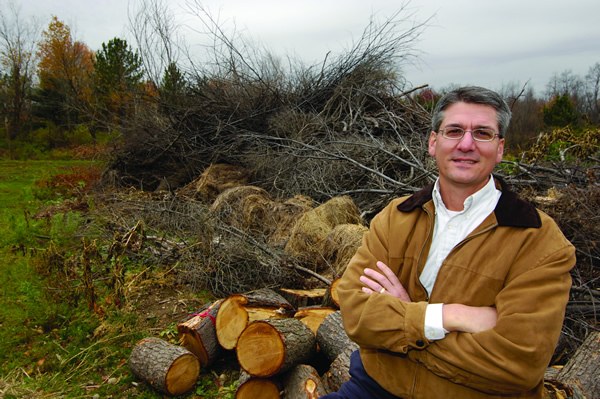Trees may be the key to the state's energy future.

Dr. Charles Ray, sees enormous potential for biofuels in PA's forests; Photo by Pat Little
Wood products experts Dr. Charles Ray, Dr. Paul Blankenhorn, Dr. Nicole Brown, Dr. Jeffrey Catchmark, and forest economist Dr. Charles Strauss contend that concentrating on a sustainable harvest of smaller, under-utilized "remnant" trees could yield a huge amount of ethanol.
Pennsylvania's forests are rich in potential bioenergy from small-diameter trees that are overcrowded and underutilized and that inhibit the opportunity for professional management. Using the U.S. Forest Service's most recent Forest Inventory Analysis data for Pennsylvania, the Pennsylvania Hardwoods Small-Diameter Task Force recently estimated that as much as 500 million tons of wood are held in these small-diameter stems. Annual sustainable harvest of six million dry tons of wood per year could be converted into various bio-energy sources.
According to Dr. Charles Ray, assistant professor of wood products operations, six million dry tons per year is the rough equivalent raw-material usage of 18 wood ethanol plants producing 540 million gallons of ethanol per year. He thinks the potential for Pennsylvania--and especially the state's heavily forested northern tier--is huge.
Dr. John Carlson, associate professor of molecular genetics and director of the Schatz Center for Tree Molecular Genetics, also is studying the use of trees for biomass. He served on a steering committee for the International Poplar Genome Consortium, which helped the U.S. Department of Energy chart a path for the ground-breaking genome sequencing of the poplar tree. Populus was chosen as the first tree genome to sequence due to its rapid growth rate, small genome size, and widespread use in plantation forests.
"The sequencing of the poplar genome is a bonanza for researchers seeking to understand how individual genes influence the growth of trees and their adaptation to the natural environment," Dr. Carlson explains. "We are trying to apply this knowledge to the breeding of fast-growing trees capable of producing wood, fiber, and energy on a smaller amount of land."
But before biofuels can be made in any quantity from woody plants such as trees, scientists must learn how the cell walls can be broken down so that the plant's constituent sugars can be converted to an alcohol such as ethanol.
Dr. Jeffrey Catchmark, a faculty member with a shared appointment in the College of Agricultural Sciences and the College of Engineering, and colleagues are using novel atomic force micrcoscopy techniques to study the role that substances called "expansins" play in cell walls. Dr. Catchmark explains, "It's a promising line of inquiry that might yield new insights into the structure of the plant cell wall, which would be useful in the design of new cellulosic materials. The idea is that someday we might genetically modify plants for ethanol production."
Dr. Nicole Brown, assistant professor of wood chemistry, also is wrestling with the question of how to break down the cell walls of woody plants. Collaborating with other Penn State researchers, she has been pulled into biomass research because of her expertise on how wood polymers behave. Polymers are long strings of molecules that determine the structure of materials such as trees.
"After plants are genetically manipulated to produce different kinds of enzymes and proteins, we study how those compounds affect the properties of plant polymers," Dr. Brown says. "The thought is that these protein and enzyme-based modifications will make the woody tissue easier to disassemble. That will make it easier to access the sugars that will make ethanol."

